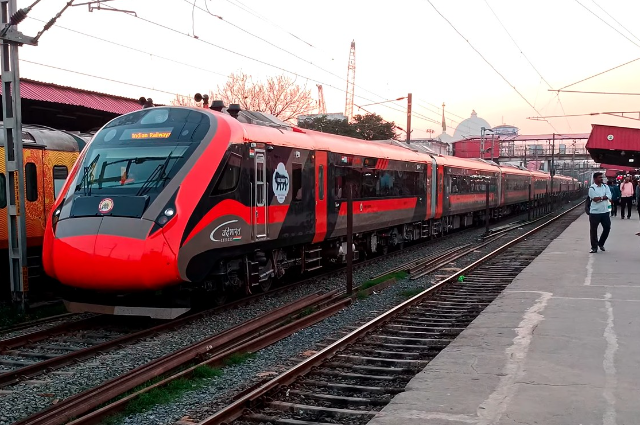The transformation of India's railway infrastructure has reached a significant milestone with the recent inauguration of 103 redeveloped railway stations across the nation. This momentous achievement represents more than just infrastructure upgrades; it symbolises a comprehensive vision for modernising India's transportation backbone under the leadership of Prime Minister Narendra Modi.
The virtual inauguration ceremony, which took place has showcased the government's commitment to revolutionizing railway infrastructure through strategic investments and forward-thinking policies. This initiative demonstrates how centralized vision combined with state-level execution can create tangible improvements in public infrastructure that directly benefits millions of Indian citizens.
Madhya Pradesh Emerges as a Manufacturing Hub for Modern Trains
Madhya Pradesh Chief Minister Dr. Mohan Yadav's announcement regarding the upcoming manufacturing of Vande Bharat train coaches in Bhopal represents a strategic shift in India's railway manufacturing ecosystem. This development signifies not only industrial growth for the state but also the decentralization of critical infrastructure manufacturing capabilities.
The decision to establish Vande Bharat coach manufacturing in Bhopal reflects the government's commitment to creating employment opportunities while building indigenous manufacturing capacity. This initiative aligns with the broader "Make in India" philosophy, ensuring that India's advanced railway technology is produced domestically, reducing dependence on foreign manufacturers and creating a robust supply chain.
State-Level Infrastructure Development Success
The redevelopment of six railway stations in Madhya Pradesh that is Narmadapuram, Katni South, Shridham, Shajapur, Seoni, and Orchha at a cost of Rs 84 crore demonstrates the targeted approach to infrastructure improvement. Each of these stations serves different demographic and economic segments, ensuring that both urban and semi-urban areas benefit from modernized railway facilities. These stations now offer enhanced passenger amenities, improved accessibility features, and modern architectural designs that reflect local cultural elements while maintaining functional efficiency. The investment represents a significant upgrade in passenger experience and operational capabilities for these regional transportation hubs.
Amrit Bharat Station Scheme: A Nationwide Transformation
The inauguration of 103 redeveloped stations spanning 86 districts across 18 states and union territories represents an unprecedented scale of railway infrastructure modernization. The Rs 1,100 crore investment demonstrates the government's commitment to ensuring equitable development across different regions of the country.
This nationwide approach ensures that railway modernization is not concentrated in metropolitan areas alone but extends to smaller cities and towns that serve as crucial connectivity nodes. The scheme addresses long-standing infrastructure gaps and provides standardized facilities across the railway network.
Enhanced Passenger Experience and Operational Efficiency
The Amrit Bharat Station Scheme goes beyond aesthetic improvements to focus on functional enhancements that improve both passenger experience and operational efficiency. These stations feature modern amenities, better crowd management systems, improved safety measures, and enhanced accessibility for differently-abled passengers.
The redeveloped stations incorporate sustainable design principles, energy-efficient lighting systems, and waste management facilities that align with environmental consciousness. These improvements create a foundation for long-term operational sustainability while reducing the environmental footprint of railway operations.
Ambitious Expansion Plans for India's Train Fleet: Massive Rolling Stock Enhancement Program
Railway Minister Ashwini Vaishnaw's announcement of expanding India's train fleet represents one of the most ambitious railway expansion programs in recent history. The planned addition of 200 new Vande Bharat trains, 100 AMRUT Bharat trains, 50 Namo Bharat Rapid Rail services, and 17,500 general non-AC coaches over the next two to three years will significantly enhance the railway's capacity and service quality.
This expansion addresses multiple segments of railway transportation, from premium high-speed services to affordable general passenger services. The diverse range of train types ensures that modernization benefits passengers across different economic segments while maintaining the inclusive nature of Indian Railways.
Technology Integration and Service Quality Improvement
The introduction of advanced train technologies through Vande Bharat and rapid rail services represents India's commitment to adopting world-class railway standards. These trains incorporate modern safety features, improved passenger comfort, energy-efficient operations, and reduced travel times between major cities.
The substantial increase in general non-AC coaches ensures that modernization does not compromise the affordability that makes Indian Railways accessible to the broader population. This balanced approach maintains social equity while upgrading infrastructure standards.
Financial Framework Supporting Railway Modernization: Record Budget Allocation for Infrastructure Development
The allocation of Rs 2,52,000 crore as Gross Budgetary Support to the Ministry of Railways for the financial year 2025-26 represents a historic investment in railway infrastructure. This substantial financial commitment demonstrates the government's recognition of railways as a critical component of national economic development.
The budget allocation maintains consistency with the previous fiscal year's spending while incorporating additional provisions for specialized programs. This sustained investment approach ensures continuity in infrastructure projects and allows for long-term planning and execution.
Diversified Funding Mechanisms for Comprehensive Development
The railway modernization program utilizes multiple funding sources to ensure comprehensive development. Beyond the gross budgetary support, the inclusion of Rs 10,000 crore from extra-budgetary resources brings the total capital expenditure to Rs 2,62,000 crore, significantly expanding the scope of possible improvements.
The integration of specialized funds, including Rs 200 crore from the Nirbhaya Fund for safety measures, demonstrates a holistic approach to railway development that addresses not only infrastructure but also passenger security and comfort. This diversified funding strategy ensures that railway modernization addresses multiple dimensions of passenger needs and operational requirements.
Building the Future of Indian Transportation
The comprehensive railway modernization initiative represents more than infrastructure development; it embodies a vision for transforming India's transportation landscape to support economic growth, social connectivity, and technological advancement. The combination of station redevelopment, manufacturing capacity building, fleet expansion, and substantial financial investment creates a foundation for sustained progress in railway services.
This initiative demonstrates how coordinated policy implementation, strategic financial allocation, and technology adoption can create transformational change in public infrastructure. As India continues to grow economically and demographically, these railway improvements will serve as crucial enablers for mobility, commerce, and social integration across the nation.
. . .
References:

